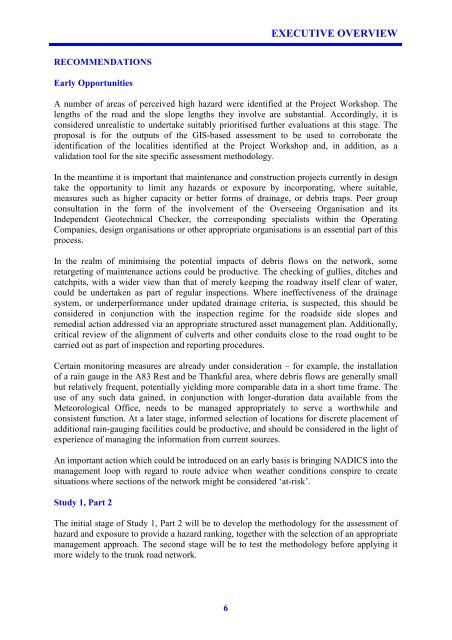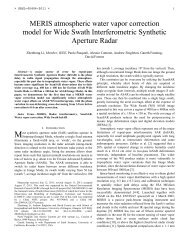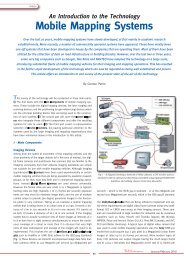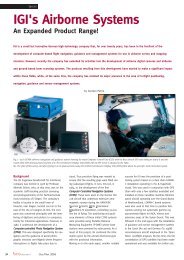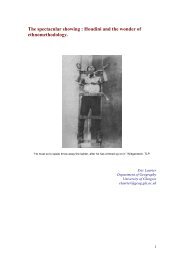Scottish Road Network Landslides Study - University of Glasgow
Scottish Road Network Landslides Study - University of Glasgow
Scottish Road Network Landslides Study - University of Glasgow
Create successful ePaper yourself
Turn your PDF publications into a flip-book with our unique Google optimized e-Paper software.
RECOMMENDATIONS<br />
Early Opportunities<br />
6<br />
EXECUTIVE OVERVIEW<br />
A number <strong>of</strong> areas <strong>of</strong> perceived high hazard were identified at the Project Workshop. The<br />
lengths <strong>of</strong> the road and the slope lengths they involve are substantial. Accordingly, it is<br />
considered unrealistic to undertake suitably prioritised further evaluations at this stage. The<br />
proposal is for the outputs <strong>of</strong> the GIS-based assessment to be used to corroborate the<br />
identification <strong>of</strong> the localities identified at the Project Workshop and, in addition, as a<br />
validation tool for the site specific assessment methodology.<br />
In the meantime it is important that maintenance and construction projects currently in design<br />
take the opportunity to limit any hazards or exposure by incorporating, where suitable,<br />
measures such as higher capacity or better forms <strong>of</strong> drainage, or debris traps. Peer group<br />
consultation in the form <strong>of</strong> the involvement <strong>of</strong> the Overseeing Organisation and its<br />
Independent Geotechnical Checker, the corresponding specialists within the Operating<br />
Companies, design organisations or other appropriate organisations is an essential part <strong>of</strong> this<br />
process.<br />
In the realm <strong>of</strong> minimising the potential impacts <strong>of</strong> debris flows on the network, some<br />
retargeting <strong>of</strong> maintenance actions could be productive. The checking <strong>of</strong> gullies, ditches and<br />
catchpits, with a wider view than that <strong>of</strong> merely keeping the roadway itself clear <strong>of</strong> water,<br />
could be undertaken as part <strong>of</strong> regular inspections. Where ineffectiveness <strong>of</strong> the drainage<br />
system, or underperformance under updated drainage criteria, is suspected, this should be<br />
considered in conjunction with the inspection regime for the roadside side slopes and<br />
remedial action addressed via an appropriate structured asset management plan. Additionally,<br />
critical review <strong>of</strong> the alignment <strong>of</strong> culverts and other conduits close to the road ought to be<br />
carried out as part <strong>of</strong> inspection and reporting procedures.<br />
Certain monitoring measures are already under consideration – for example, the installation<br />
<strong>of</strong> a rain gauge in the A83 Rest and be Thankful area, where debris flows are generally small<br />
but relatively frequent, potentially yielding more comparable data in a short time frame. The<br />
use <strong>of</strong> any such data gained, in conjunction with longer-duration data available from the<br />
Meteorological Office, needs to be managed appropriately to serve a worthwhile and<br />
consistent function. At a later stage, informed selection <strong>of</strong> locations for discrete placement <strong>of</strong><br />
additional rain-gauging facilities could be productive, and should be considered in the light <strong>of</strong><br />
experience <strong>of</strong> managing the information from current sources.<br />
An important action which could be introduced on an early basis is bringing NADICS into the<br />
management loop with regard to route advice when weather conditions conspire to create<br />
situations where sections <strong>of</strong> the network might be considered ‘at-risk’.<br />
<strong>Study</strong> 1, Part 2<br />
The initial stage <strong>of</strong> <strong>Study</strong> 1, Part 2 will be to develop the methodology for the assessment <strong>of</strong><br />
hazard and exposure to provide a hazard ranking, together with the selection <strong>of</strong> an appropriate<br />
management approach. The second stage will be to test the methodology before applying it<br />
more widely to the trunk road network.


